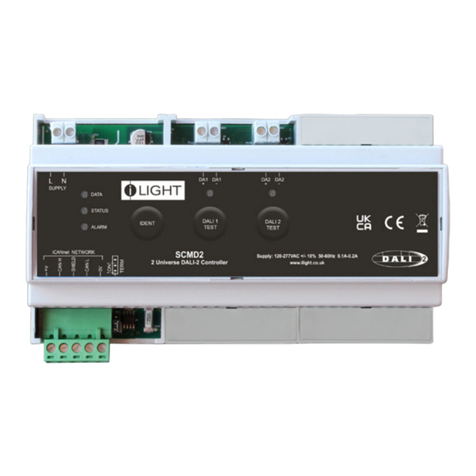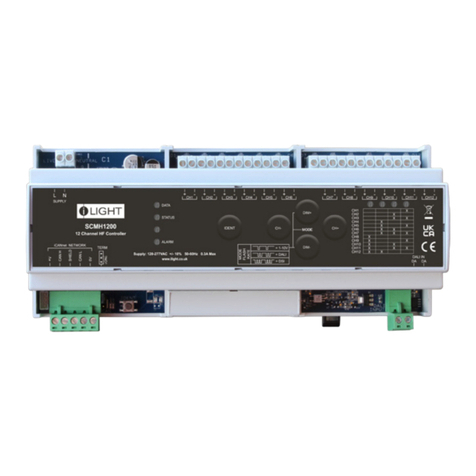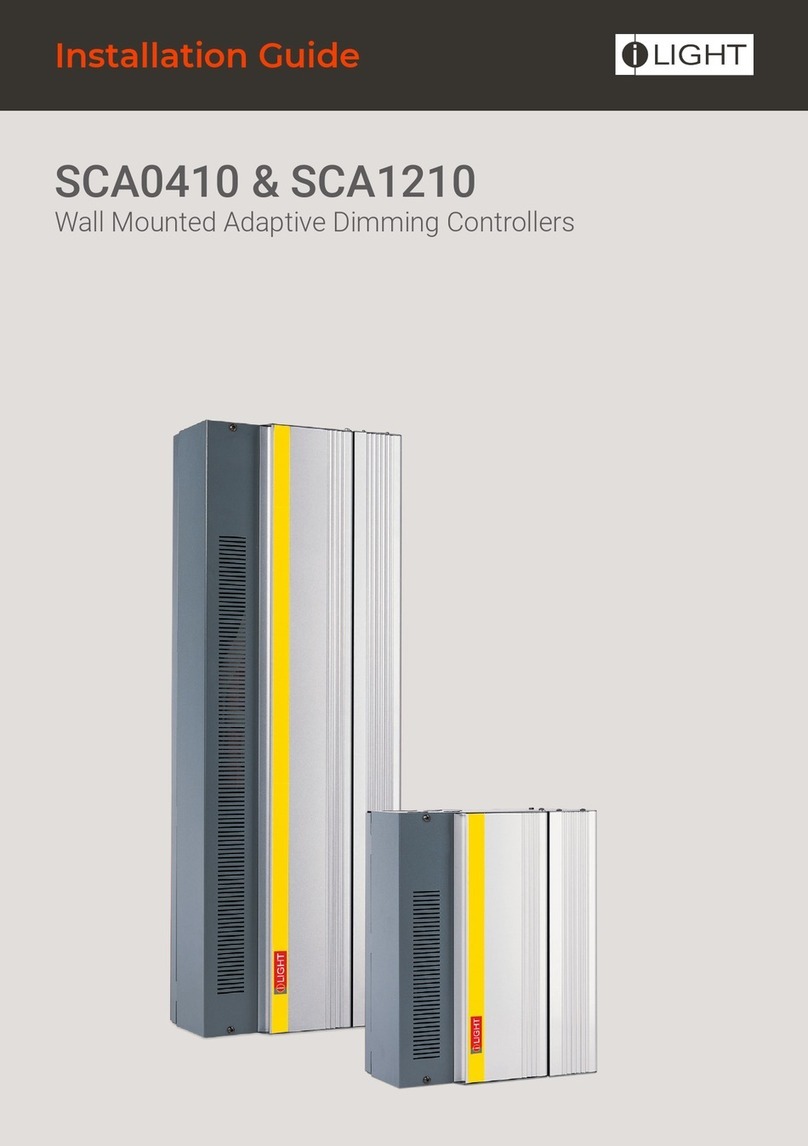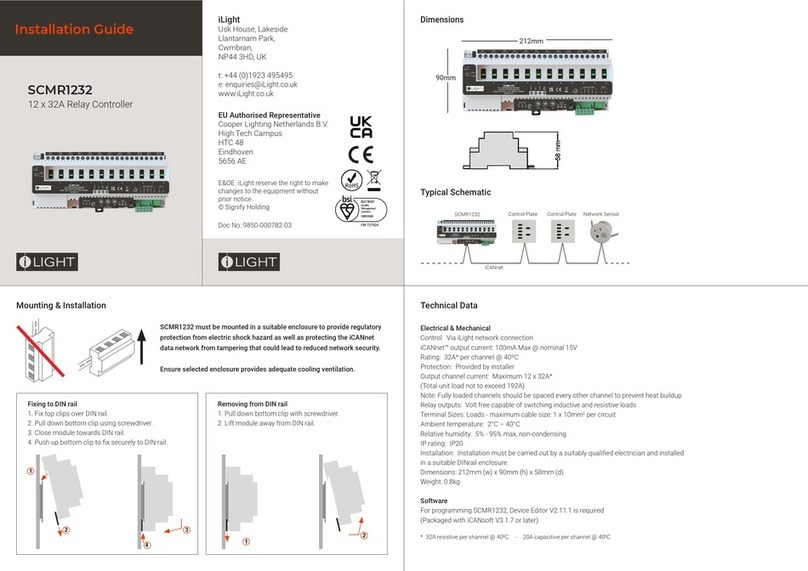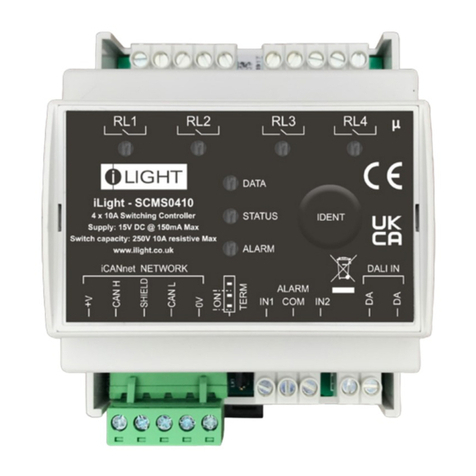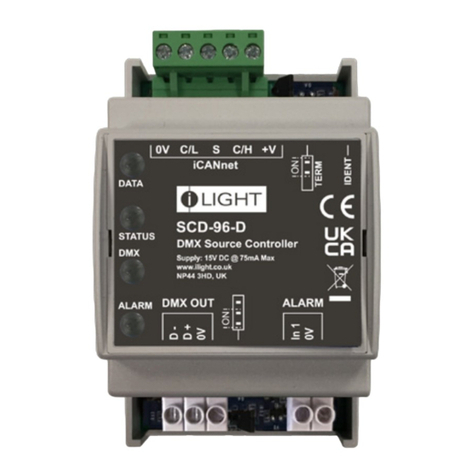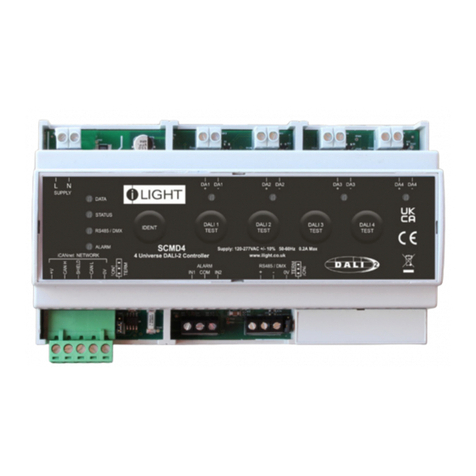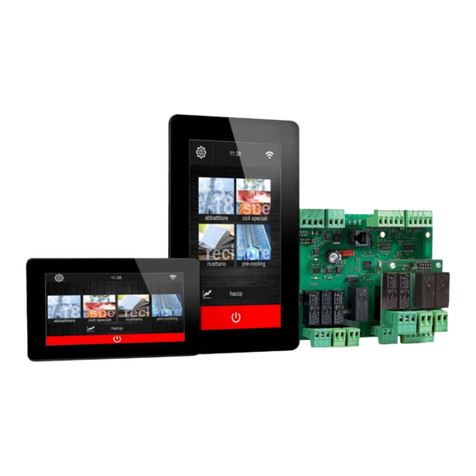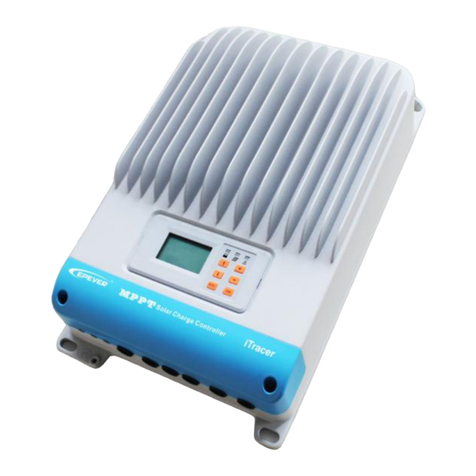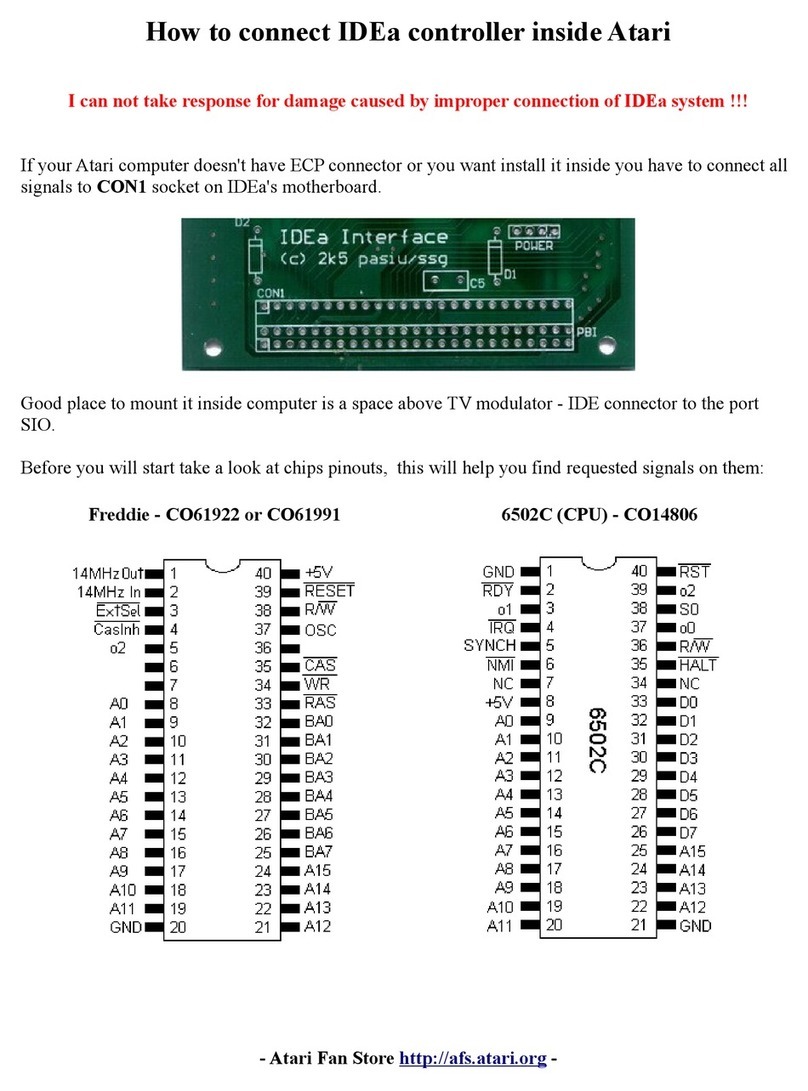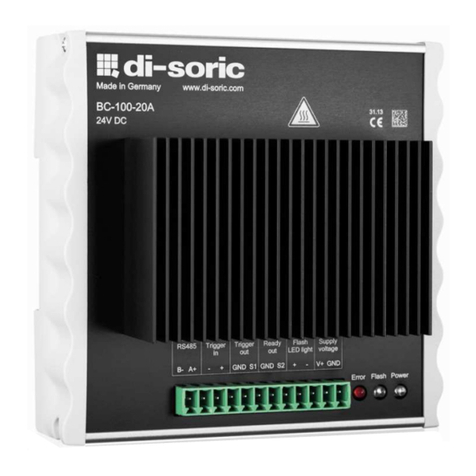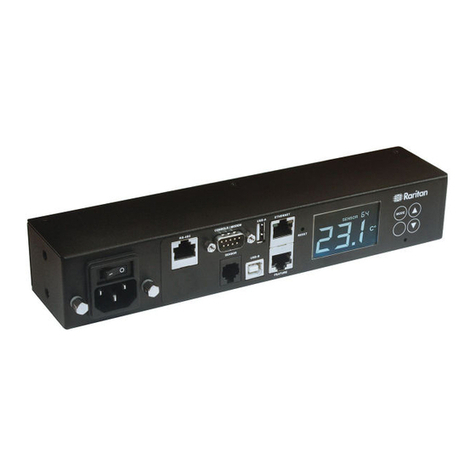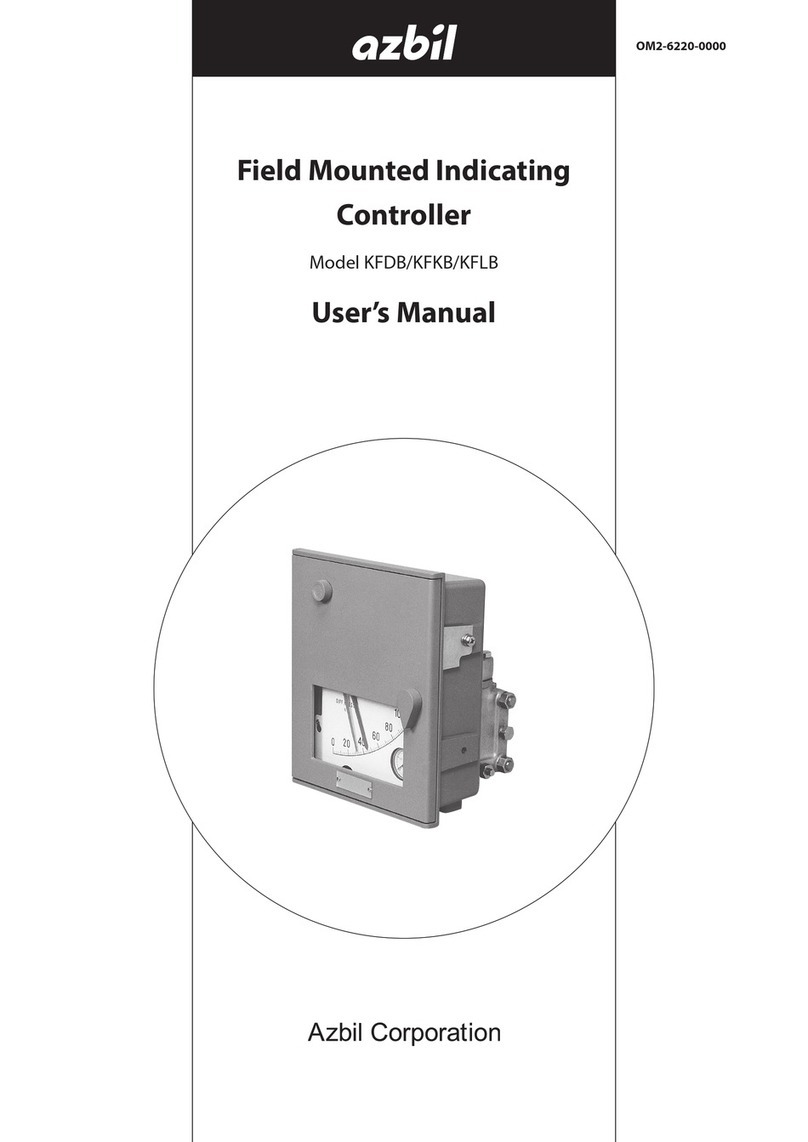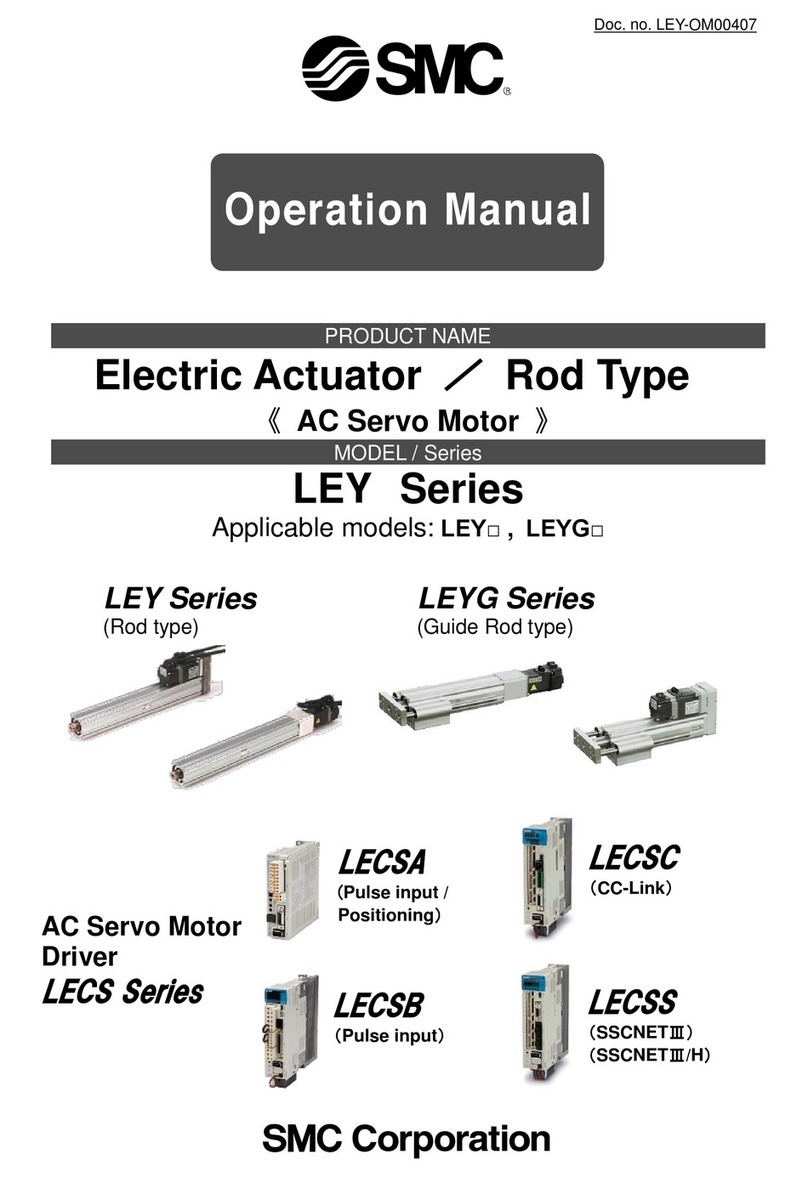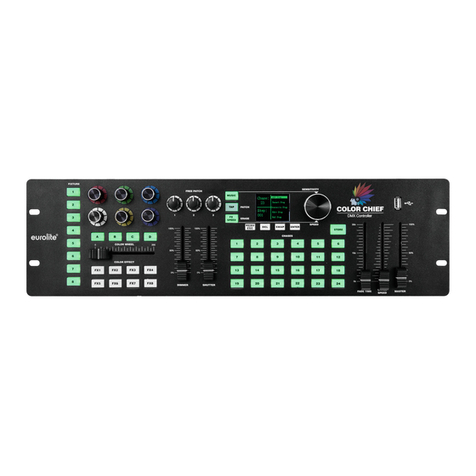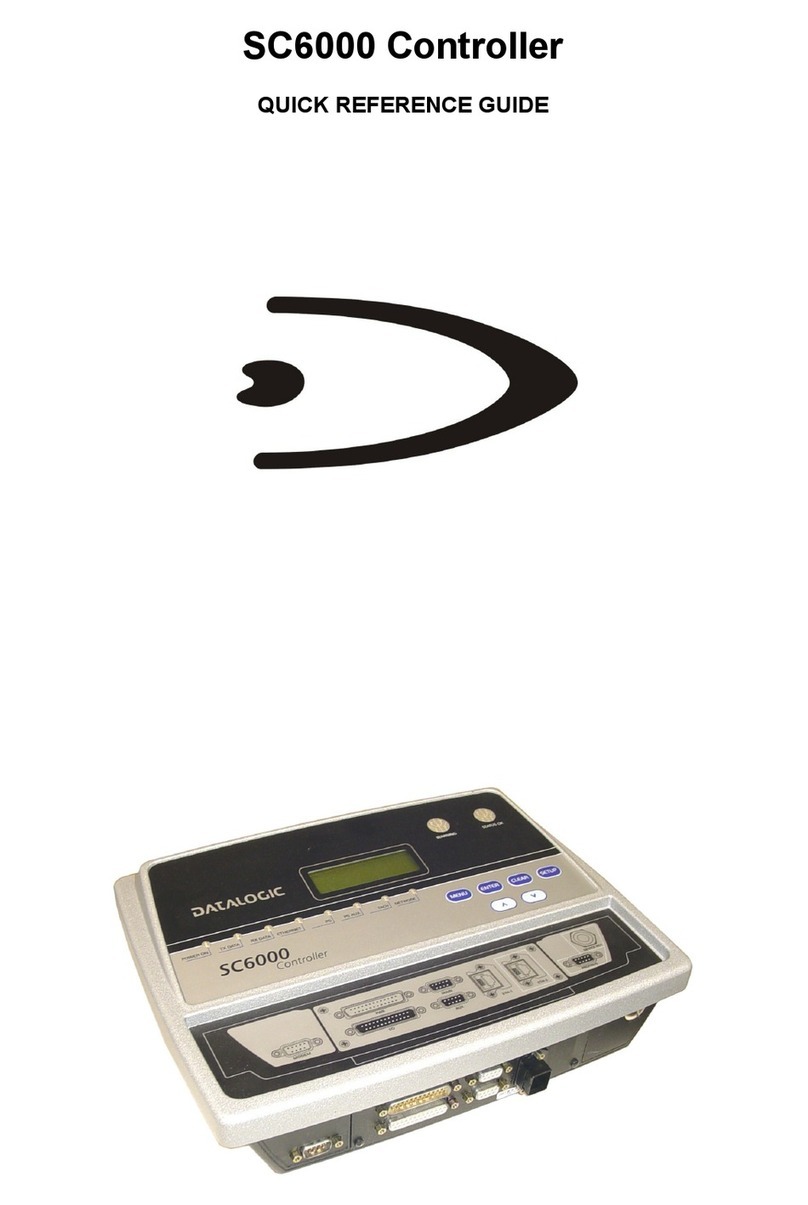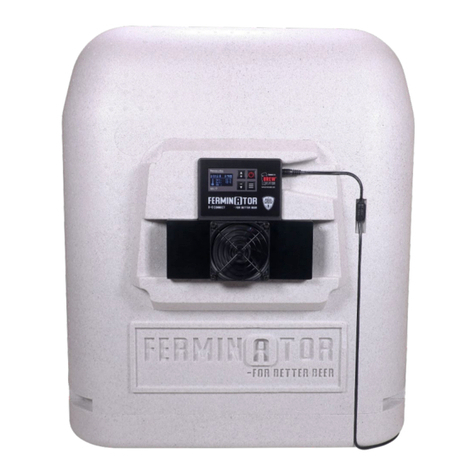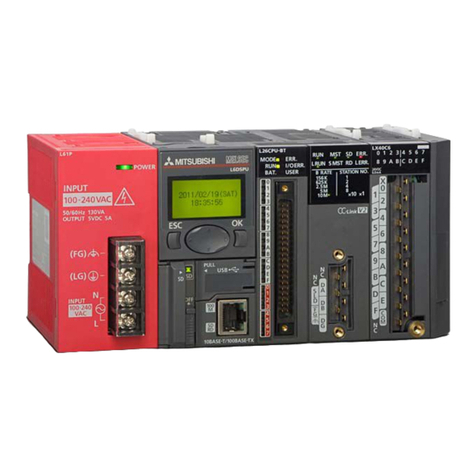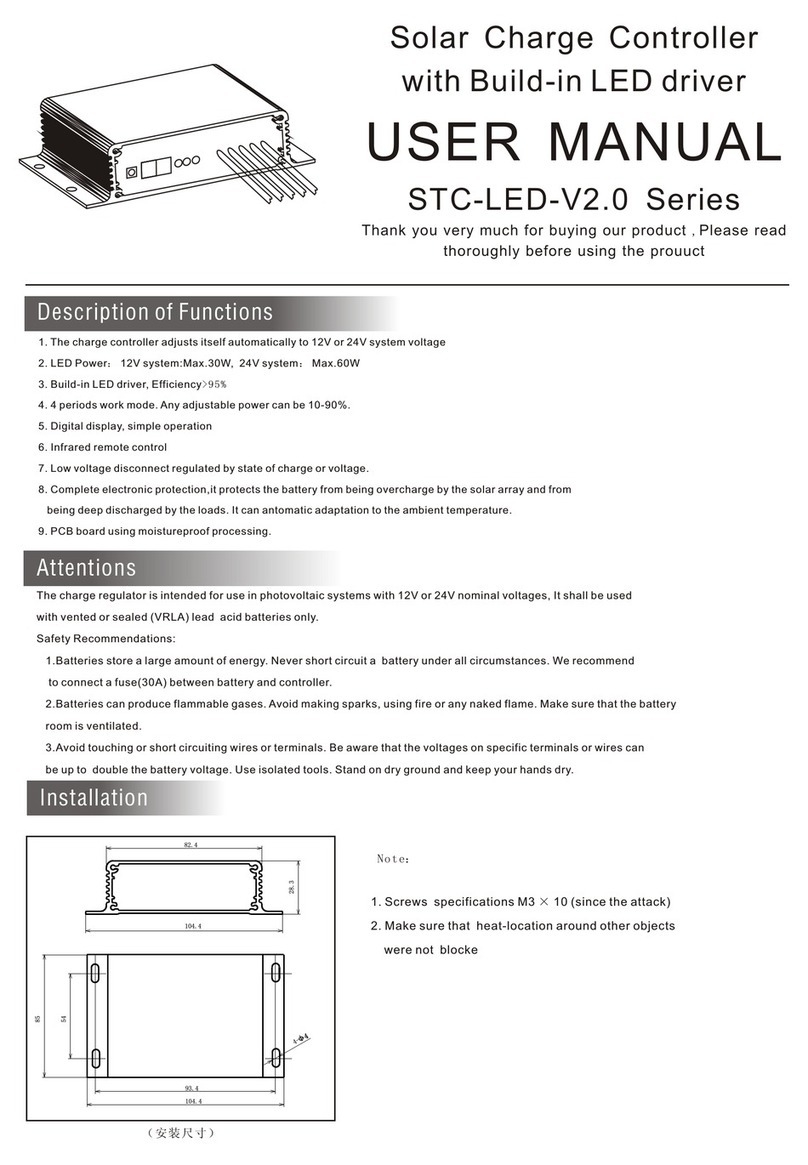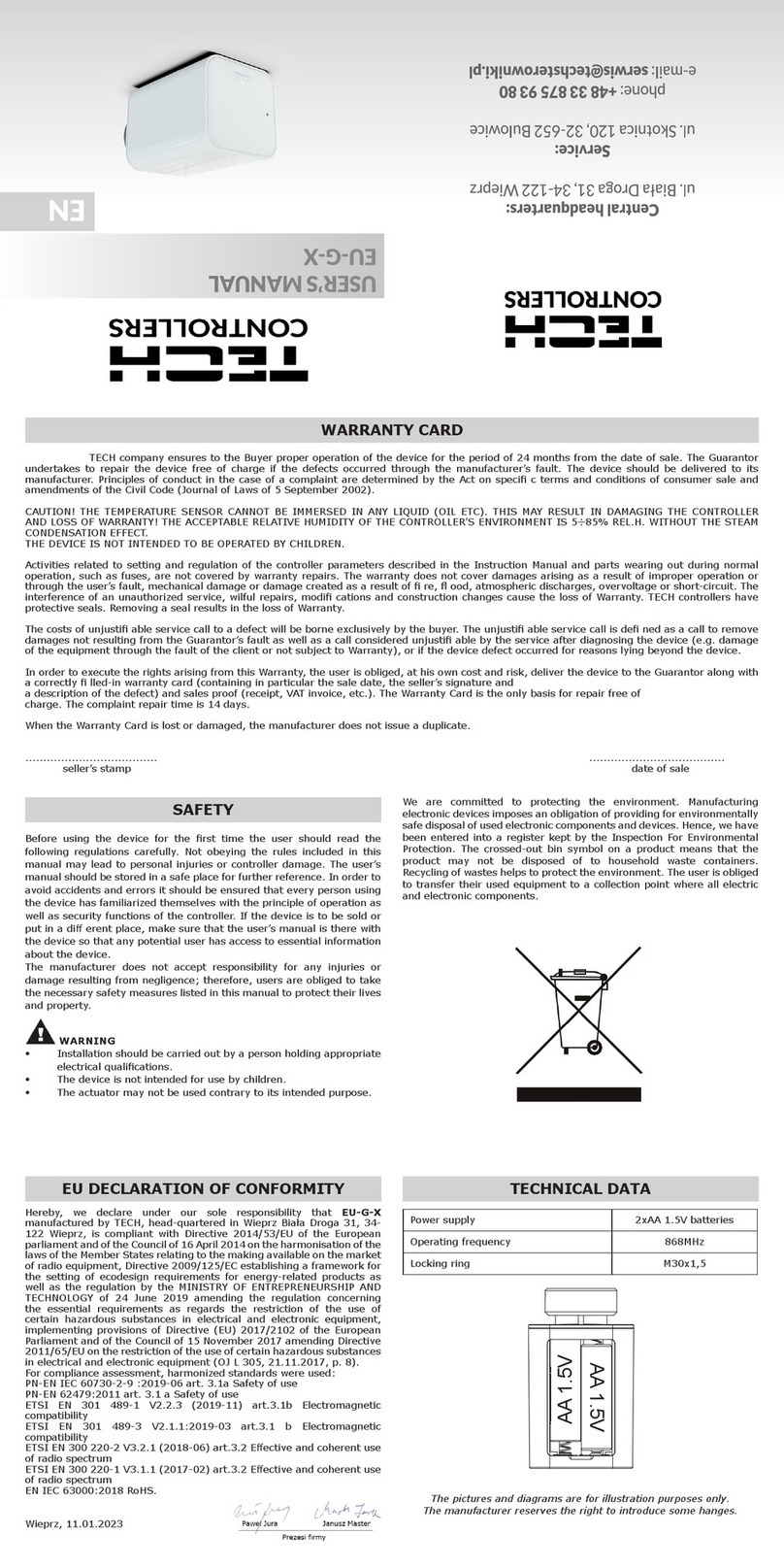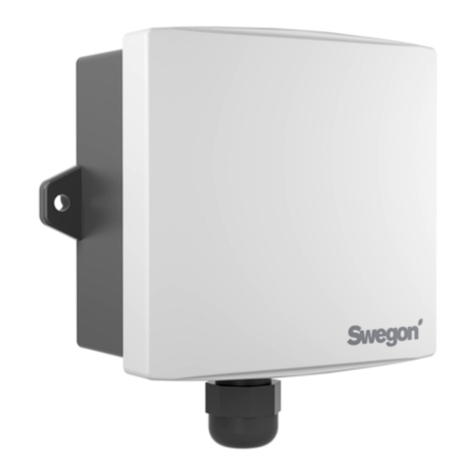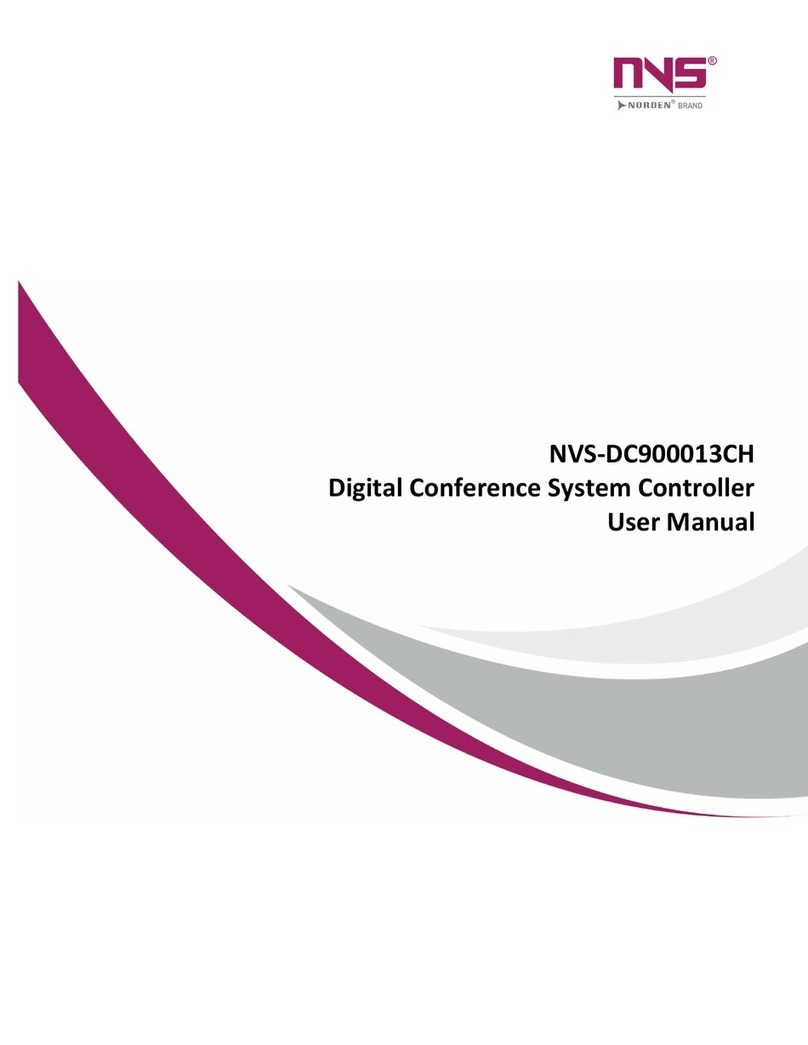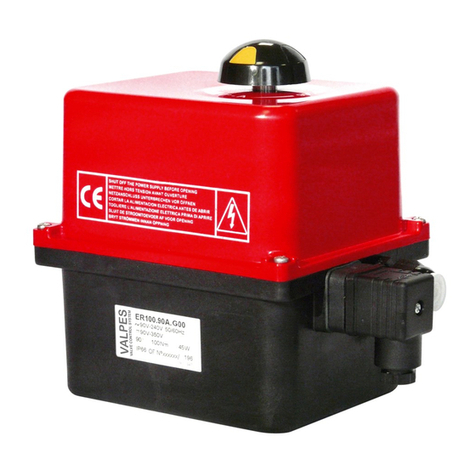iLight SCI0405 User manual

Contents
2 Warning
3 Installation
5 Supply and load connections
7 iCAN Network
8 ASCII control messages
9 Typical system schematics
10 Service switches and LEDs
12 Specifications
- Inductive
- H F Ballast
- Power Switching
- Adaptive
- Trailing Edge
Instruction Manual
Read this document prior to installation
Source Controllers INTELLIGENT CONTROLS


2 of 23
INTELLIGENT CONTROLS

Where?
Source Controllers (Racks) should be located in a
ventilated dry location where the ambient temperature
is within the operating range of the controller. When
choosing the installation location take the following
into account:
l Depending on the size of the loads connected
to an Inductive or Adaptive Source Controller
it will get warm. Adequate ventilation
should be provided to ensure the ambient
temperature does not rise above 40oC.
l Allow adequate space for future maintenance
of the unit. Do not install in a location that
will later be inaccessible.
l Instal only on a vertical surface.
l Depending on Source Controller type and
the loads connected, Source Controllers can
create noise. This is caused by electrical noise
suppression components within the unit. The
noise is a low level buzz that varies with the
level of dimming. If noise of this type causes a
problem, locate the Source Controller
elsewhere.
Source Controllers require ventilation and have slots
on all sides to allow for a convection flow of air
through the unit. For this reason it is important to
orientate the unit correctly and allow a minimum
space between adjacent Source Controllers and
other surfaces. A minimum of 100mm of free space
should be left either side of a Source Controller or
between adjacent Controllers.
IMPORTANT NOTE
Mounting the Source Controller in the wrong
orientation, without proper ventilation or with
inadequate airflow could result in overheating.
3 of 23
Installation Instructions
If a Source Controller is connecting to trunking
of depth 50mm or less, then it may be coupled
directly as shown below.
Leave 100mm of free space between
other equipment, walls etc. either side
of the equipment.
If the trunking depth is greater than 50mm,
installation of Source Controllers should be as
shown below.
Typical installation for trunking less than 50mm
depth. Source Controller connected directly to
trunking.
Typical installation where trunking depth is
greater than 50mm. Controller connected to
trunking using conduit couplers.
INTELLIGENT CONTROLS

4 of 23
Installation Instructions
Simply calculate the load for each channel, add
all the loads together and this will be the size
of the supply you require. Always calculate the
supply assuming all channels working at full
output simultaneously.
For a Source Controller being fed from a 3-Phase
supply, calculate the load on each phase and
fit externally to the Controller, a suitably rated
3-pole circuit breaker. Do not apply power until
you are certain that a good Neutral connection is
present at the Source Controller.
Sample supply requirement calculations:
Example 1 - Resistive loads connected to a
4 channel 5A Inductive Source Controller.
(SCI0405S)
Channel 1 load is 300Watts
Channel 2 load is 150Watts
Channel 3 load is 1000Watts
Channel 4 load is 500Watts
Total connected load = 1950Watts
(All loads in this example are resistive or have
unity power factor).
For the this example the minimum size of the
supply required is: 1950W/230V = 8.5Amps
Therefore, the unit should be fed with a supply
of
at least 10Amps.
As the individual load channels are protected by
5Amp MCB’s a supply capable of delivering
more than 10Amps could be used, but it is
recommended that it should not exceed the
rating shown on the label fitted inside the door.
Example 2 - Fluorescent lamps with dimmable
HF ballasts connected to a 4 channel 10A
High Frequency Ballast Source Controller.
(SCH0410S)
Channel 1 load is 8 x 58 Watt tubes
Channel 2 load is 16 x18 Watt tubes
Channel 3 load is 10 x 26 Watt PL lamps
Channel 4 load is 5 x 36 Watt tubes
Total connected load = 1192Watts
(All loads in this example have unity power
factor).
For this example the minimum size of supply
required is: 1192W / 230V = 5.18 Amps
Therefore the unit should be fed with at least
6 Amps supply.
How?
Remove the unit cover to gain access to the fixing
holes.
Four screws hold on the cover of the Source
Controller; two are visible from the front and two
are visible only when the MCB cover door is opened.
There is no need to remove the MCB door.
Four fixings holes are provided allowing for fixings
up to 6mm diameter.
4 Channel version shown (SCI0405S)
Supply and Load Connections
Size of supply
The size of the supply required to the Source
Controller is dependent on the power requirements
of the loads connected to it.
(inside door)
(inside door)
INTELLIGENT CONTROLS

5 of 23
The diagram above shows the power supply
connections to a single phase Source Controller.
The Live supply is connected directly to one of the
channel MCBs or Mains Isolator if fitted. These are
factory fitted with a busbar linking them together.
Do not remove the busbar or any other cables
already connected to the MCBs or Isolator. The
maximum supply cable size is 16mm2.
The Neutral supply cable is connected to the neutral
busbar terminal (except in the case of a Source
Controller fitted with Neutral disconnect circuit
breakers, where connection is to the neutral busbar
fitted to circuit breakers).
An earth connection must be made to the chassis,
using the Earth stud. It is important that all supply
and neutral connections are tight. There is also
a diagram on the cover of the unit showing the
connections.
Supply & Load Cable Terminations
Connections to 3-Phase units are similar, except
that live connections must be made to three
sequential MCB’s. For example RED to MCB 1;
YELLOW to MCB 2; BLUE to MCB 3. The MCBs
are fitted on the supply side with a 3-phase
busbar which distributes the incoming supply
sequentially to all twelve breakers.
Load Cable Terminations
Load cables are connected to the column of
terminal blocks located on the left hand side of
a Source Controller. These terminals are labelled
L1,E, N1 L2,E, etc… and will accept up to 6mm2
cables.
It is important that each load circuit neutral is
connected to the appropriate neutral terminal
within the Source Controller. Failure to observe
this could result in electrical interference affecting
other equipment. Do not use a common neutral
for multiple loads.
The Load terminals of 3 phase units are phase
sequential as follows:
L1 Phase 1 (R)
L2 Phase 2 (Y)
L3 Phase 3 (B)
L4 Phase 1 (R)
L5 Phase 2 (Y)
L6 Phase 3 (B)
.
.
.
L11 Phase 2 (Y)
L12 Phase 3 (B)
Note Adaptive dimmers (Source Controllers with
prefix SCA.....) are shipped in Switch mode,
and will be set (according to type of connected
load) by the commissioning engineer. Please
retain all information concerning the type of load
transformers that are installed (for each dimmer
channel), so as to assist this process.
WARNING: Meggers must not be used on any
circuitry that is connected to iLight equipment. To
avoid damage, load cables must be disconnected
prior to any such testing.
HF Ballast Controllers - Connection of
low voltage cables
(Applies only to Source Controllers with prefix
SCH...) For each individual load circuit, there should
be a pair of cables linking all ballast LV connections
together (paying due attention to polarity), and
terminating at the relevant connections in the
Source Controller.
4 Channel inductive version shown
IMPORTANT:
Ensure that load cables are connected to the relevant
type of Source Controller in accordance with iLight
project drawing (normally supplied with quotation).
For example:
Source Controllers with part no. SCI..... are dimmers,
eg for tungsten or inductive loads.
Source Controllers with part no. SCI08..... are dual
units, incorporating four dimmers (O/P’s 1 to 4) and
four O/P’s (5 to 8) with corresponding 0-10v (or DSI)
connections for HF Ballasts.
Source Controllers with part no. SCH..... are HF
ballast controllers, eg for 0-10v fluorescent fittings.
Source Controllers with part no. SCS..... are switching
units, eg for non-dimmable luminaires.
Source Controllers with part no. SCA..... are adaptive
dimmers - eg where there is a mixture of inductive
and capacitive loads.
Source Controllers with part no. SCT..... are trailing
edge dimmers - eg where “trailing edge” dimming is
required on some circuits.
Supply Cable Terminations
INTELLIGENT CONTROLS

Networks and Connecting Control
Cables
Network control cables should enter the Source
Controller through the segregated route shown
in the diagram below (A).
Ensure the CAT5 data cable is linked into all
Source Controllers in this manner.
Segregation between Control Data cabling and
power wiring should be maintained for safety
and noise immunity. Control Data cabling should
be run in separate or divided metal trunking
or conduits. Where cables are run outside
trunking or conduit then there should be 300mm
separation between them, and where they cross
they should do so at right angles.
Terminals for network and RS485 connections
use two-part connectors allowing connections
to be made outside of the Source Controller.
Simply pull the connectors from the board
A Source controller is connected to other devices,
control panels, Source Controllers, audio-visual
systems and interfaces using the iCAN network
or a RS485 data connection. The RS485 data
connection is designed for use primarily with
external systems and does not offer the full
functionality and integrity that use of the iCAN
network can provide. All other iLight products
communicate with each other using the iCAN
network. At no point should the RS485 and iCAN
networks be joined together.
Ensure each low voltage pair is terminated at the
connection corresponding to the associated mains
pair - for example all ballasts which are fed with 230
volts from MCB 2 must have their low voltage cable
terminated at 0V and DIM2.
If there is any doubt concerning which cable carries
mains, this must be resolved (using a voltmeter) before
connecting to the Source Controller. Connecting a
mains potential cable to the Low Voltage terminals
will damage the unit and invalidate warranty.
HF Ballast types:
The Source Controller is able to control either Analogue
or DSI (digital) ballasts, with each channel individually
configurable. This selection is normally made as part
of commissioning, but it is also possible to “group
configure” all outputs to one or other of the two
standards. Source Controllers are ex-factory shipped
set for Analogue ballasts. The procedure to alter this
to DSI (for all channels) is:
Isolate the Source Controller.
Locate the 3-way DIPswitches on the processor pcb.
Move switch 1 to the ON position.
Return power to the Source Controller.
(to return to Analogue, reverse the above process)
Emergency Luminaires
Any luminaries that require a Permanent Live feed
must be wired with an additional (identified) live
cable, fed from the right-hand (protected) side of
the relevant MCB. Install your Permanent Live cable
together with the existing brown cable. Use only the
MCB which relates to the circuit in question.
Additional Lighting Connections
Diagram shows typical connection of
emergency lighting circuit and the entry
point of the network control cable (A).
Note
Control and network cables do not include the
0-10V or DSI control cables that are connected to
controllable ballasts. The control cables to ballasts
should be regarded as power cables and segregated
from the CAN and RS485 cables that connect to the
source controller.
6 of 23
Permanent
Live
INTELLIGENT CONTROLS

Two sets of terminals are provided for the connection
of iCANnet cables. Both iCAN terminals on the
control board are connected in parallel.
The recommended cable to use for iCANnet is: CAT5
FTP such as RS part numbers 196-331 for 305m or
298-0885 for 1000m.
The Control Board paralleled iCANnet terminals are
labelled with the recommended colours of the pairs
in CAT5 cable to use.
Orange pair +12V
Blue/White CAN-H
Blue CAN-L
Green pair 0V
Brown pair Shield
The structure of an iCAN network is shown in the
diagram below.
In the above example, resistors should be fitted at the
two ends of the network as marked with asterisks(*).
The devices on an iCAN network may be wired in
any order, but the network must be one continuous
“daisy-chain”. Spurs are NOT permitted, as this is
liable to result in communication problems.
Source Controllers and Control Panels are all shipped
with a 120 ohm Termination resistor fitted on the
iCANnet termination block. At all locations other
than the two end-of-line positions, the resistors
should be removed. Except where isolating Bridge
Nodes are installed, every iCAN network requires
two Termination resistors only.
iCANnet Connections
RS485 Control
The RS485 Control terminals are located adjacent
to the iCAN network terminals.
The terminals to be used are labelled:
RS485-
RS485+
0V
See the ASCII control message section on
page 13.
RJ12 Connector
The Source Controller is fitted with an RJ12
socket to allow local connection of a handheld
programmer or PC interface.
No connection should be made to the factory
pins of the connector.
Alarm Input
An alarm input, designed for connection to a fire
alarm system, is available on the same terminal
block as the RS485 connections. The terminals
to be used for an Alarm input are:
0V
AL
Any connection to this input MUST be volt free
and have a cable length of less than 50 metres.
Cabling for this input should be segregated from
power wiring.
The default action that occurs when these
terminals are linked is for every channel of the
source controller to turn on to maximum output.
It will then remain in this state, regardless of
any other command received, until the link
between the 0V and AL terminals is removed.
Only when the alarm link is removed can levels
be changed.
On an entire iCAN network only one fire alarm
input is required.
7 of 23
INTELLIGENT CONTROLS

ASCII Control Messages
8 of 23
ASCII Control Messages provide a simple method of
control for AV systems. This is done by sending a string
of ASCII characters via the in-built RS485 serial port in
the Source Controllers.
The command is not case sensitive.
1.1 Message Syntax
The general form of the message is:
1.1.1 Start Character
Each message starts with the @ character
The command is started receiving the @ character.
If a command is incomplete when a new @ is received,
the old command is discarded.
1.1.2 Command
The start character is followed by a two character
command.
Example: SS (select scene)
1.1.3 Parameters
After the command characters several characters define
the parameters, such as the scene number, area
number, and fade time.
A colon delimits the values. If a colon is received after
only 1 digit then a single digit value is assumed. <O:
P</O:P
1.1.4 End Character
The command is ended with a carriage return, <cr> (13
dec). The # character can also be used.
1.3 Virtual Control Messages
Virtual control messages are used to control the system,
and not individual devices. The message is transmitted
across the iCANnet network to all other devices.
1.3.1 Command SS Select Scene
This message selects a scene in an area.
The syntax is: @SSxx:Axx:Fxx<cr>
SSxx defines the scene number, where xx is valid from
00 to 99. Scene 00 is OFF.
Axx defines the Area Number, valid for 00 to 99.
Fxx defines the Fade Time , valid for 00 to 99 for
seconds.
1.3.2 Command SA Save Scene
This message saves the current levels to a scene in an
area.
The syntax is: @SAxx:Axx<cr>
SAxx defines the scene number, where xx is valid from
00 to 99. Scene 00 saves to the current scene.
Axx defines the Area Number, valid for 00 to 99.
1.3.3 Command RS Request Current Scene
This message requests the current scene number in an
area.
The syntax is: @RSxx<cr>
RSxx defines the Area Number, valid for 01 to 99.
1.3.4 Command RE Report Current Scene
This message reports the current scene number in an
area. The syntax is: @RExx:Axx<cr>
RExx defines the Scene Number, valid for 01 to 99.
Axx defines the Area Number, valid for 01 to 99.
1.3.5 Command SC Set Channel Level
This message sets the level of a channel in an area.
The syntax is: @SCxx:Axx:Lxx:Fxx<cr>
SCxx defines the channel number, where xx is valid
from 00 to 99. Channel 00 affect ALL channels in
an area.
Axx defines the Area Number, valid for 00 to 99.
Lxx defines the Level, valid for 00 to 99 in %, and FF
for FULL (100%)
Fxx defines the Fade Time , valid for 00 to 99 for
seconds.
1.3.6 Command RC Request Channel Level
This message request the level of a channel in an
area.
The syntax is: @RCxx:Axx<cr>
RCxx defines the channel number, where xx is valid
from 00 to 99. Channel 00 requests ALL channels in
an area. (use with caution).
Axx defines the Area Number, valid for 00 to 99.
1.3.7 Command RL Report Channel Level
This message reports the current level of a channel
in an area.
The syntax is: @RLxx:Axx:Lxx<cr>
RLxx defines the Channel Number, valid for 01 to
99.
Axx defines the Area Number, valid for 00 to 99.
Lxx defines the Level, valid for 00 to 99 in %, and FF
for FULL (100%)
1.3.8 Command CR Raise
This message increments the area by 1% level
The syntax is: @CRxx:Axx <cr>
CRxx defines the channel number, where xx is valid
from 00 to 99. Channel 00 affect ALL channels in
an area.
Axx defines the Area Number, valid for 00 to 99.
1.3.9 Command CL Lower
This message decrements the area by 1% level
The syntax is: @CLxx:Axx <cr>
CLxx defines the channel number, where xx is valid
from 00 to 99. Channel 00 affect ALL channels in
an area.
Axx defines the Area Number, valid for 00 to 99.
1.3.10 Command SF Stop Fade
This message stops fading in an area
The syntax is: @SFxx:Axx <cr>
SFxx defines the channel number, where xx is valid
from 00 to 99. Channel 00 affect ALL channels in
an area.
Axx defines the Area Number, valid for 00 to 99.
1.3.11 Command TC Toggle Channel
This message toggles a channel state.
The syntax is: @TCxx:Axx:Lxx:Fxx<cr>
TCxx defines the channel number, where xx is valid
from 00 to 99. Channel 00 affect ALL channels in
an area.
Axx defines the Area Number, valid for 00 to 99.
Lxx defines the Level, valid for 00 to 99 in %, and
FF for FULL (100%)
Fxx defines the Fade Time , valid for 00 to 99 for
seconds.
INTELLIGENT CONTROLS

Typical System Schematic
9 of 23
Commissioning
Please retain any Job-specific drawings or
schedules relating to load connections at the Source
Controllers. This information is required by the
commissioning engineer to assist in configuration
of the equipment.
When first energised after installation all Source
Controllers will default to all channels being at 100%
output.
Source Controllers can be energised without network
cables being terminated.
If iCANnet cables are terminated after Source
Controllers have been energised it should be noted
that cables will be carrying low voltage signals and
mis-connection of these could result in damage to
other devices on the network.
Factory Set Source Controller Settings
All channels set to Area 1
Physical Channel No = Virtual Channel No
Power Up Scene = Last Scene Selected (From
factory last scene selected will be Scene 1 - all
channels at 100%.
Alarm Input set to operate with contact closing
AL terminal to 0V.
Factory Set Scenes
Scene Level
1 100%
2 70%
3 50%
4 30%
5 80%
6 60%
7 40%
8 20%
INTELLIGENT CONTROLS

Service Switches and LEDs
10 of 23
These switches and LEDs are located at the base of
the unit.
The two service switches on the source controllers
are used for the following:
l Entering Diagnostic Mode.
l Putting the Source Controller in override
mode.
l Sending a message to identify the device on
the network.
Sending a message to identify the device on the
network.
The LEDs indicate the following:
l Normal operation.
l Message transmission and receipt.
l Override status
ICANnet error status will occur when a Source
Controller is not connected to an iCAN network for
any reason. Once either connected to a network of
one or more other devices which are powered the
error status will be removed. It is still possible to
enter Diagnostic mode if a Source Controller is in
iCANnet error status.
INTELLIGENT CONTROLS

General Specifications
11 of 23
INTELLIGENT CONTROLS

General Specifications
12 of 23
Key Features
l128 scene memory.
lMultiple choice of circuit protection.
lSecurity door for MCB’s (where fitted).
lFail to full safety feature.
liCANnet™ inputs (10,000 node enabled).
lAudio Visual port (RS485).
lAlarm input.
lCE mark compliant for all relevant standards.
lFuture proof with FLASH memory.
lDesigned and manufactured to ISO9000 standards.
lEmergency Lighting Terminals.
Mechanical Data
Climate Range
lTemperature: - 20ºC to +40ºC.
lHumidity: +5 to 95 % non-condensing.
Control Inputs
lTwo sets of terminals for the iCANnet™ suitable
for CAT5 FTP.
lOne RJ12 socket for the programming of iCANnet™.
lOne set of terminals for the Audio Visual port, RS485.
lOne set of terminals for alarm input.
Electrical Data
Terminal Sizes
lLoads, maximum cable size: 1 x 4 mm2or
2 x 2.5 mm2per circuit.
liCANnet cable size: 5 x 1mm2.
lAudio Visual Port: RS485 2 x 1mm2.
lAlarm input: 2 x 1mm2.
Memory
lFLASH memory to be able to upgrade firmware
EEPROM for 128 scene memory.
Fade Times
l0.1 seconds to 60 minutes.
Mains Stabilisation
l50:1.
Mains Isolators
Isolators are standard on the following Source Controllers
SCH1210S & SCH1210N
SCH1220S & SCH1220N
SCS1210S & SCS1210N
SCS1220S & SCS1220N
SCI1205S & SCI1205N
SCI1210S & SCI1210N
SCI1220S & SCI1220SN
See SCT1205S for details of isolator wiring.
Isolators are NOT fitted to the following products
'D' (double pole) versions
SCI0805S
SCI0805N
Special order products that use different mechanics
SCI0405
SCH0410
SCS0410
SCS0420
SCI0805T
All iLight Source Controllers have the following specifications:
INTELLIGENT CONTROLS

Inductive Source Controllers
Euro version
lMains Cable Access: 12 x PG16 and 1 x PG29
knockouts.
lControl Cable Access: 1 x PG16 knockout.
SCI1220
lWeight: 18kg
UK version
lMains Cable Access: 12 x 25 mm, 1 x PG29
knockouts.
lControl Cable Access: 1 x 25 mm knockout.
Euro version
lMains Cable Access: 12 x PG16 and 1 x PG29
knockouts.
lControl Cable Access: 1 x PG16 knockout.
Electrical Data
SCI0405
lMaximum Load: 20 Amp single phase @ 40ºC.
lMaximum Channel Current: 6 Amps.
lSupply: 230 volts -/+ 10% 50/60 Hz.
(optionally, 127 volt 60 Hz).
lProtection: 4 x 6 Amp MCB’s type C, 6KA rated.
SCI0410
lMaximum Load: 40 Amp single phase @ 40ºC.
lMaximum Channel Current: 10 Amps.
lSupply: 230 volts -/+ 10% 50/60 Hz.
(optionally, 127 volt 60 Hz).
lProtection: 4 x 10 Amp MCB’s type C, 6KA rated.
SCI1205
lMaximum Load: 40 Amp single phase @ 40ºC.
lMaximum Channel Current: 6 Amps.
lSupply: 230 volts -/+ 10% 50/60 Hz.
(optionally, 127 volt 60 Hz).
lProtection: 12 x 6 Amp MCB’s type C, 6KA rated.
SCI1210
lMaximum Load: 40 Amp three phase @ 40ºC.
lMaximum Channel Current: 10 Amps.
lSupply: 415/230 volts -/+ 10% 50/60 Hz.
(optionally, 220/127 volt 60 Hz).
lProtection: 12 x 10 Amp MCB’s type C, 6KA rated.
SCI1220
lMaximum Load: 63 Amp three phase @ 40ºC.
lMaximum Channel Current: 20 Amps.
lSupply: 415/230 volts -/+ 10% 50/60 Hz.
(optionally, 220/127 volt 60 Hz).
lProtection: 12 x 20 Amp MCB’s type C, 6KA rated.
Load Types
lIncandescent 230 volt lamps.
lInductive Wire wound (allow for 10% transformer
losses).
lLeading edge electronic transformers.
lCold Cathode (Check the iLight™ help desk for details).
Minimum Load
l20 watts per channel.
Dimmed Outputs
SCI0405, SCI0410
l4 x 40 Amp rated Triacs.
SCI1205, SCI1210, SCI1220
l12 x 40 Amp Triacs.
Switched Outputs
lThe Dimmed outputs may be configured as switches,
for non-dimmed loads. They require a minimum load
of 30mA for them to latch. Before connecting
Discharge lamps, consult with the iLight™ help desk.
Terminal Sizes
lIncoming supply, maximum cable size: 10mm2.
SCI0405S - Single pole
SCI0405N - Neutral disconnect
SCI0410S - Single pole
SCI0410N - Neutral disconnect
SCI0410D - Double pole
SCI1205S - Single pole
SCI1205N - Neutral disconnect
SCI1210S - Single pole
SCI1210N - Neutral disconnect
SCI1210D - Double pole
SCI1220S - Single pole
SCI1220N - Neutral disconnect
SCI1220D - Double pole
Common specifications as detailed on
page 12 plus the following:
Key Features
SCI0405
l- 4 x 5 Amp fully rated Source Controller.
SCI0410
l- 4 x 10 Amp fully rated Source Controller.
SCI1205
l- 12 x 5 Amp fully rated Source Controller.
SCI1210
l- 12 x 10 Amp fully rated Source Controller.
SCI1220
l- 12 x 20 Amp Source Controller.
lDims resistive, inductive and low voltage electronic
transformer loads (That are compatible with leading
edge dimmers).
lQuiet operation.
Mechanical Data
SCI0405
lWeight: 4kg.
lMains Cable Access: 4 x 25 mm, 4 x PG16 and 1 x
PG21knockouts.
lControl Cable Access: 1 x 25 mm, 1 x PG16
knockouts.
SCI0410
lWeight: 7kg.
lMains Cable Access: 4 x 25 mm, 4 x PG16 and 1 x
PG21knockouts.
lControl Cable Access: 1 x 25 mm, 1 x PG16
knockouts.
SCI1205
lWeight: 10kg.
UK version
lMains Cable Access: 12 x 25 mm, 1 x PG29
knockouts.
lControl Cable Access: 1 x 25 mm knockout.
Euro version
lMains Cable Access: 12 x PG16 and 1 x PG29
knockouts.
lControl Cable Access: 1 x PG16 knockout.
SCI1210
lWeight: 18kg.
UK version
lMains Cable Access: 12 x 25 mm, 1 x PG29
knockouts.
lControl Cable Access: 1 x 25 mm knockout.
13 of 23
INTELLIGENT CONTROLS

Inductive Source Controllers
14 of 23
SCI1205S
INTELLIGENT CONTROLS
RS485
RS485
oV
AL
Output Status LEDs
Load Terminals Supply Earth Terminals
RJ12 iCANnet
Socket
Control Board
+12V
Orange Pair
CAN-H
Blue/White
CAN-L
Blue
0V
Green Pair
SHIELD
Brown Pair
Supply & Load Cable entry knockouts
Control Cable entry knockouts Service switches
and LEDs
+12V
Orange Pair
CAN-H
Blue/White
CAN-L
Blue
0V
Green Pair
SHIELD
Brown Pair
Channel Circuit Breakers
MAINS IN
RS485 & Alarm
Terminals
iCANnet
Terminals

SCH0410
lMaximum Load: 40 Amp single phase @ 40ºC.
lMaximum Channel Current: 10 Amps.
lSupply: 230 volts -/+ 10% 50/60 Hz.
(optionally, 127 volt 60 Hz).
lProtection: 4 x 10 Amp MCB’s type C, 6KA rated.
SCH1210 - As 0410 but 3 phase + 12 x 10 Amp.
SCI0805
lMaximum Load: 40 Amp single phase @ 40ºC.
lMaximum Channel Current: 5 Amps.
lSupply: 230 volts -/+ 10% 50/60 Hz (same phase).
lProtection: 1 x 20 Amp Double pole input MCB’s
type C, 6KA rated.
SCH1200
lMaximum Load: There is no load control.
lPower switching is achieved by the DSI ballasts
themselves.
lMaximum Channel Current: Not applicable.
lSupply: 1 x 230 volts -/+ 10% 50/60 Hz.
lProtection: Thermal non resetting fuse.
SCH0410
Dimmed Outputs
l4 x 1-10 volt at 0.1 Amp sink current per channel.
l4 x Tridonic DSI outputs (uses electronic power
switching in ballasts).
Switched Outputs
l4 x 230 volt 10A (inductive or resistive).
SCH1210
Dimmed Outputs
l12 x 1-10 volt at 0.1 Amp sink current per channel.
l12 x Tridonic DSI outputs (uses electronic power
switching in ballasts).
Switched Outputs
l12 x 230 volt 10A (inductive or resistive).
SCI0805
Dimmed Outputs
l4 x 1-10 volt at 0.1 Amp sink current per channel.
l4 x Tridonic DSI outputs (uses electronic power
switching in ballasts).
l4 x 5 Amp inductive.
Switched Outputs
l4 x 230 volt 5A (inductive or resistive).
SCH1200T
Dimmed Outputs
l12 x 0-10 volts at 0.1 Amp sink current per channel.
l12 x Tridonic DSI outputs (uses electronic power
switching in ballasts).
Switched Outputs
lNone.
Terminal Sizes
SCH0410, SCH1210, SCI0805
lIncoming supply, maximum cable size: 10mm2.
SI0805T
lIncoming supply, cable rated for 40 Amp or to
correspond to input supply voltage.
lMaximum cable size 10mm2.
SCH1200T
lIncoming supply, maximum cable size: 2.5mm2
lBallast output, maximum cable size: 12 pairs
2.5 mm2per circuit.
SCH0410S - Single pole 4 channels
SCH0410N - Neutral disconnect “
SCH0410D - Double pole “
SCH1210S - Single pole 12 Channels
SCH1210N - Neutral disconnect “
SCH1210D - Double pole “
SCI0805T - Single pole - Dual unit
SCI0805S - Single pole “
SCI0805N - Neutral disconnect “
SCH1200T - Terminals - 12 Channel, no relays
Common specifications as detailed on page
12 plus the following features:
Key Features
SCH0410S
l40 Amp fully rated source controller.
SCH1210
l120 Amp total box load on 4 circuits.
SCI0805
l40 Amp total box load on 1 supply.
SCH1200
lA 12 channel device source controller.
lSuitable for both 0-10 volt analogue and DSI ballasts.
lQuiet operation.
Mechanical Data
SCH0410
lWeight: 4kg.
lMains Cable Access: 4 x 25 mm, 4 x PG16 and 1 x
PG21knockouts.
lControl Cable Access: 1 x 25 mm, 1 x PG16
knockouts.
SCH1210
lWeight: 7.5kg.
UK version
lMains Cable Access: 12 x 25 mm, 1 x PG29
knockouts.
lControl Cable Access: 1 x 25 mm knockout.
Euro version
lMains Cable Access: 12 x PG16 and 1 x PG29
knockouts.
lControl Cable Access: 1 x PG16 knockout.
SCI0805
lWeight: 7.5kg.
lMains Cable Access: 4 x 25 mm, 4 x PG16 and 1 x
PG21knockouts.
lControl Cable Access: 1 x 25 mm, 1 x PG16
knockouts.
SCH1200T
lWeight: 3kg.
lMains Cable Access: 2 x 25 mm and 2 x PG16
knockouts.
lControl Cable Access: 1 x 25 mm and 1 x PG16
knockouts.
Electrical Data
Load Types
l1-10volt HF Fluorescent, 100 per channel.
lDSI & DALI Fluorescent Ballasts
SCH0410 & SCI0805, 32 / channel. 128 / unit
SCH1210, SCH1220 & SCH1200T, 64 / channel; 128 / unit
l0-10 volt Iris control 20K Ohm input).
l1-10 volt Multi-Load transformers 100 (control only).
HF Ballast Controllers
15 of 23
INTELLIGENT CONTROLS

HF Ballast Controllers
16 of 23
SCI0805S
SCH1200T
HF Control Connections
Option Switch
SCH0410S
INTELLIGENT CONTROLS
Channel Circuit Breakers
Load Terminals Supply Earth Terminals
RJ12 iCANnet Socket
Load Terminals Supply Earth Terminals
HF Control Connections
Channel Circuit Breakers
HF Control Connections
Control Board
Option SwitchOption Switch
+12V
Orange Pair
CAN-H
Blue/White
CAN-L
Blue
0V
Green Pair
SHIELD
Brown Pair
RS485
RS485
oV
AL
+12V
Orange Pair
CAN-H
Blue/White
CAN-L
Blue
0V
Green Pair
SHIELD
Brown Pair
+12V
Orange Pair
CAN-H
Blue/White
CAN-L
Blue
0V
Green Pair
SHIELD
Brown Pair
RS485
RS485
oV
AL
+12V
Orange Pair
CAN-H
Blue/White
CAN-L
Blue
0V
Green Pair
SHIELD
Brown Pair
+12V
Orange Pair
CAN-H
Blue/White
CAN-L
Blue
0V
Green Pair
SHIELD
Brown Pair
RS485
RS485
oV
AL
+12V
Orange Pair
CAN-H
Blue/White
CAN-L
Blue
0V
Green Pair
SHIELD
Brown Pair
Mains Supply In
Supply & Load Cable entry knockouts Supply & Load Cable entry knockouts
Control Cable entry knockouts
Control Cable entry knockouts Service switches
and LEDs
Service switches
and LEDs
Service switches
and LEDs
Control Board
RJ12 iCANnet Socket
RJ12 iCANnet Socket
Control Board
MAINS IN
MAINS IN
RS485 & Alarm
Terminals
iCANnet
Terminals
RS485 & Alarm
Terminals
iCANnet
Terminals
RS485 & Alarm
Terminals
iCANnet
Terminals

SCS1210S - Single pole
SCS1210N - Neutral disconnect
SCS1220S - Single pole
SCS1220N - Neutral disconnect
Common specifications as detailed on
page 12 plus the following features:
Key Features
lTwelve channels of switching for resistive, inductive
or capacitive lighting loads.
lQuiet operation.
SCS1210
l12 x 10 Amp fully rated switching Source Controller.
SCS1220
l12 x 20 Amp Source Controller.
Mechanical Data
SCS1210, SCS1220
lWeight: 7.5kg.
UK version
lMains Cable Access: 12 x 25 mm, 1 x PG29
knockouts.
lControl Cable Access: 1 x 25 mm knockout.
Euro version
lMains Cable Access: 12 x PG16 and 1 x PG29
knockouts.
lControl Cable Access: 1 x PG16 knockout.
Switched Relay Controllers
17 of 23
Electrical Data
Load Types
lThis unit is designed to work with most lighting load
types. Please consult with the iLight™ help desk for
guidance on true load calculations. Care should be
taken when specifying discharge lighting sources.
Switched Outputs
lThis device uses 12 x 230 volt 20A (resistive and
inductive) relays.
Terminal Sizes
lIncoming supply, maximum cable size: 10mm2.
SCS1210
lMaximum Load: 40 Amp three phase @ 40ºC.
lMaximum Channel Current: 10 Amps.
lSupply: 415/230 volts -/+ 10% 50/60 Hz.
(optionally, 220/127 volt 60 Hz).
lProtection: 12 x 10 Amp MCB’s type C, 6KA rated.
SCS1220
lMaximum Load: 63 Amp three phase @ 40ºC.
lMaximum Channel Current: 20 Amps.
lSupply: 415/230 volts -/+ 10% 50/60 Hz.
(optionally, 220/127 volt 60 Hz).
lProtection: 12 x 20 Amp MCB’s type C, 6KA rated.
INTELLIGENT CONTROLS

SCS1210S
Switched Relay Controllers
18 of 23
INTELLIGENT CONTROLS
Output Status LEDs
Option Switch Load Terminals Supply Earth Terminals
RJ12 iCANnet
Socket
Control Board
Supply & Load Cable entry knockouts
Control Cable entry knockouts Service switches
and LEDs
Channel Circuit Breakers
MAINS IN
+12V
Orange Pair
CAN-H
Blue/White
CAN-L
Blue
0V
Green Pair
SHIELD
Brown Pair
RS485
RS485
oV
AL
+12V
Orange Pair
CAN-H
Blue/White
CAN-L
Blue
0V
Green Pair
SHIELD
Brown Pair
RS485 & Alarm
Terminals
iCANnet
Terminals

SCA0410S - Single Pole
SCA0410N - Neutral Disconnect
SCA0410D - Double Pole
SCA1210S - Single Pole
SCA1210N - Neutral Disconnect
SCA1210D - Double Pole
Common specifications as detailed on
page 12 plus the following:
Key Features
SCA0410
l- 4 x 10 Amp fully rated Source Controller.
SCA1210
l- 12 x 10 Amp fully rated Source Controller.
lAuto Senses for load type, and suitable for resistive,
inductive and capacitive loads.
lComplete with iPROTECT™ lamp protection and auto
short circuit protection.
Mechanical Data
SCA0410
lWeight: 9kg.
lMains Cable Access: 4 x 25 mm, 4 x PG16 and
1 x PG21knockouts.
lControl Cable Access: 1 x 25 mm, 1 x PG16
knockouts.
SCA1210
lWeight: 18kg.
UK version
lMains Cable Access: 12 x 25 mm, 1 x PG29
knockouts.
lControl Cable Access: 1 x 25 mm knockout.
Euro version
lMains Cable Access: 12 x PG16 and 1 x PG29
knockouts.
lControl Cable Access: 1 x PG16 knockout.
Electrical Data
SCA0410
lMaximum Load: 40 Amp single phase @ 40ºC.
lMaximum Channel Current: 10 Amps.
lSupply: 230 volts -/+ 10% 50/60 Hz.
(optionally, 127 volt 60 Hz).
lProtection: 4 x 10 Amp MCB’s type C, 6KA rated.
SCA1210
lMaximum Load: 40 Amp three phase @ 40ºC.
lMaximum Channel Current: 10 Amps.
lSupply: 415/230 volts -/+ 10% 50/60 Hz.
(optionally, 220/127 volt 60 Hz).
lProtection: 12 x 10 Amp MCB’s type C, 6KA rated.
Load Types
lIncandescent 230 volt lamps.
lLow voltage inductive lamps (wire wound or
electronic).
lLow voltage electronic (capacitive).
lCold Cathode (Check the iLight™ help desk for
details).
Minimum Load
l20 watts per channel.
Dimmed Outputs
l2 x 45 Amp FET’s per circuit.
Switched Outputs
lThe Dimmed outputs may be configured as switches,
for non-dimmed loads. They require a minimum load
of 30mA for them to latch.
Terminal Sizes
SCA0410, SCA1210
lIncoming supply, maximum cable size: 10mm2.
Adaptive Source Controllers
19 of 23
INTELLIGENT CONTROLS
This manual suits for next models
4
Table of contents
Other iLight Controllers manuals
